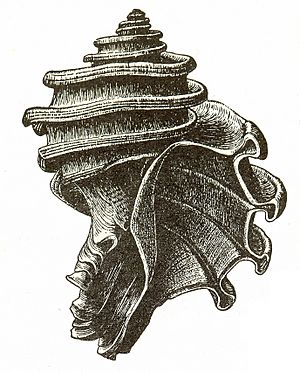Julia Anna Gardner facts for kids
Quick facts for kids
Julia Gardner
|
|
|---|---|
 |
|
| Born | January 6, 1882 |
| Died | November 15, 1960 (aged 78) |
| Nationality | American |
| Alma mater | Bryn Mawr College, Johns Hopkins University |
| Known for | Study of stratigraphy and ancient molluscs |
| Scientific career | |
| Fields | Paleontology, Geology |
| Institutions | United States Geological Survey |

Julia Anna Gardner (born January 26, 1882 – died November 15, 1960) was an important American geologist. She worked for the United States Geological Survey for 32 years. Julia Gardner was famous around the world for her studies of stratigraphy (the study of rock layers) and mollusc paleontology (the study of ancient shells and sea creatures).
Early Life and Education
Julia Gardner was born in Chamberlain, South Dakota. She was the only child of Charles Henry and Julia Gardner. Sadly, her father died when she was only four months old. Julia and her mother moved to Dixon, then later to North Adams, Massachusetts. Julia finished high school at Drury Academy in North Adams. She paid for her education with money her grandmother left her.
She went to Bryn Mawr College, where she earned her first degree in 1905. She then got her Master's degree in 1907. At college, she studied subjects like paleontology and geology.
Julia Gardner made history at Johns Hopkins University. She was the first woman to be a full-time student in their Geology Department. She earned her Ph.D. (a very high degree) in paleontology in 1911. After that, she continued to work at the university as an assistant. In 1916, her research on ancient molluscs from Maryland was published.
Professional Life and Discoveries
During World War I, Julia Gardner helped as a nurse in France. After the war, she worked with the American Friends Service Committee. She helped people in areas of France that were destroyed by the war. She returned to the United States in 1920.
Soon after, she joined the United States Geological Survey. Most of her career was spent studying ancient rock layers. These layers were found in the coastal plain, from Maryland all the way down to Mexico.
In the 1920s, she worked in Texas. She helped geologists from oil companies. She also found and identified seventy new types of fossils from Texas. Julia did a lot of research on ancient animals along the Gulf Coast of the United States. This included work in Mexico during the 1930s and 1940s.
Julia Gardner also represented the United States at important meetings. She was a delegate to the International Geological Congress in Madrid, Spain, in 1926. She also attended the Congress in Moscow in 1937.
During World War II, Julia joined a group called "The Dungeon Gang." This group was part of the Military Geology Unit. She helped prepare plans for the armed forces. She organized texts, shared ideas, and created maps. Julia was a very hard worker and everyone respected her. She even helped find the Japanese beaches where incendiary balloon bombs were launched. She did this by identifying tiny shell pieces in the sand that filled the balloons.
After the war, she visited Japan. She encouraged Japanese scientists to keep up their important work. Julia also loved art and was a founding member of the Arts Club in Washington.
Julia Gardner wrote over 40 reports. These reports became important guides for studying ancient rock layers in North America and South America. Some of her famous works include "The Midway Group of Texas" (1935) and "Mollusca of the Tertiary Formations of Northeastern Mexico" (1947).
She also wrote papers about how to classify ancient creatures, how rock layers are formed, and what ancient environments were like. Julia often did fieldwork in tough places, like parts of Mexico. She would spend weeks exploring areas that other geologists might have avoided.
Julia Anna Gardner passed away in 1960 at her home in Maryland, at the age of 78.
Awards and Honors
Julia Gardner was a member of many important scientific groups. These included the Phi Beta Kappa and Sigma Xi societies. She was also part of the Geological Society of America and the Paleontological Society. In 1925, she was named a Fellow of the American Association for the Advancement of Science.
She served as the president of the Paleontological Society in 1952. She was also the vice president of the Geological Society of America in 1953. When she retired from the United States Geological Survey, she received the Distinguished Service Medal. Many people wrote letters to Julia to show their appreciation for her. These letters were put into two books and given to her. She was admired not just for her science, but also for her kindness and friendship.
A very special honor for Julia was having an extinct snail shell named after her. This shell is called Ecphora gardnerae. In 1994, the state of Maryland made it their official state fossil shell. You can find these ecphora fossils along the Calvert Cliffs in Calvert County and St. Mary's County, Maryland.
See also
 In Spanish: Julia Anna Gardner para niños
In Spanish: Julia Anna Gardner para niños

